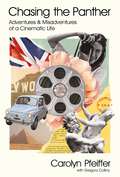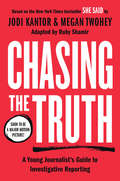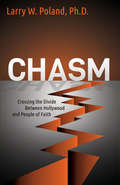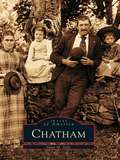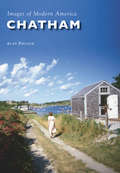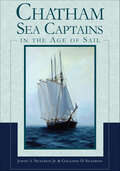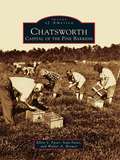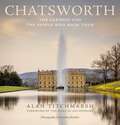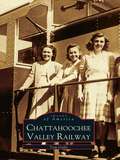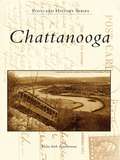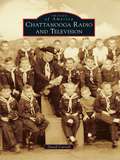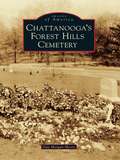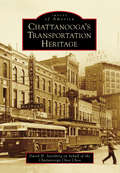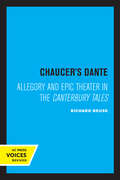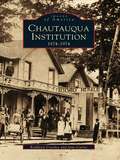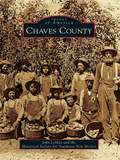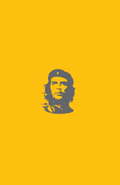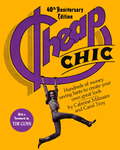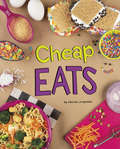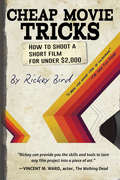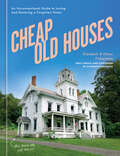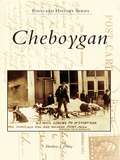- Table View
- List View
Chasing the Panther: Adventures and Misadventures of a Cinematic Life
by Carolyn PfeifferA cinematic and vibrant coming-of-age memoir, Chasing the Panther captures the thrilling and, at times, heartbreaking early years of Carolyn Pfeiffer, a pioneering film producer and one of Hollywood's first female executives—a &“mini-mogul&” in the words of the Wall Street Journal. For a moment in the 1980s, Carolyn Pfeiffer was the only woman in Hollywood who could greenlight a movie. Working with directors like Sam Shepard and Wes Craven, and with actors like River Phoenix and Bette Davis, she had a hand in producing or distributing many landmark films, among them Ridley Scott's The Duellists, Alan Rudolph's Choose Me, and the Academy Award-winning Kiss of the Spider Woman. However, long before establishing herself as a player in the world of film, Carolyn was a horseback-riding tomboy who dreamed of exploring the world beyond her small hometown. Her journey turned out to be a tale fit for the movies.As a young girl jumping from rock to rock in a rural North Carolina town, Carolyn felt a calling she couldn&’t articulate but that she nonetheless understood: it was a tug on her heart, a yearning for something more. When she could, she set out for New York City, a refuge for young women exercising their independence and resisting the pressures of marriage and motherhood. There, swept up in the glamorous world of beat poets and millionaires, Carolyn brushed shoulders with a young Burt Reynolds and became fast friends with an English journalist named Penny. As the turbulent 1960s dawned, Carolyn booked a one-way passage to Europe. Her plan was to visit Penny and to travel around Europe for the summer but, instead, the world opened up to her in ways she never could have imagined. She found herself on set with Italy&’s great filmmakers, in the couture houses of Paris&’ fashion icons, and swept up in the youthful energy flooding London. She learned about film and found work on iconic movies like Federico Fellini&’s 8 ½, Luchino Visconti&’s The Leopard, and David Lean's Doctor Zhivago, and she came to befriend and work alongside luminaries like the Beatles, Tennessee Williams, Francoise Truffaut, and Barbra Streisand. Amid these adventures and misadventures, Carolyn fell in and out of love, and was beset by tragedies and triumphs that resoundingly affirmed what she'd known since girlhood—that she was always destined for something more.Set against the dazzling backdrop of Fellini's Rome, the Paris of the French New Wave, and Swinging London, Chasing the Panther reads like a true-to-life novel revealing Carolyn&’s unforgettable journey to find her place in the world.
Chasing the Truth: She Said Young Readers Edition
by Jodi Kantor Megan TwoheyThe perfect book for all student journalists, this young readers adaptation of the New York Times bestselling She Said by Pulitzer Prize winning reporters' Jodi Kantor and Megan Twohey will inspire a new generation of young journalists. Soon to be a major motion picture!Do you want to know how to bring secrets to light?How journalists can hold the powerful to account?And how to write stories that can make a difference?In Chasing the Truth, award-winning journalists Jodi Kantor and Megan Twohey share their thoughts from their early days writing their first stories to their time as award-winning investigative journalists, offering tips and advice along the way. Adapted from their New York Times bestselling book She Said, Chasing the Truth not only tells the story of the culture-shifting Harvey Weinstein investigation, but it also shares their best reporting practices with readers. This is the perfect book for aspiring journalists or anyone devoted to uncovering the truth. Praise for the New York Times bestseller She Said: &“Exhilarating…Kantor and Twohey have crafted their news dispatches into a seamless and suspenseful account of their reportorial journey.&”— Susan Faludi, The New York Times &“An instant classic of investigative journalism...&‘All the President&’s Men&’ for the Me Too era.&”— Carlos Lozada, The Washington Post &“A vibrant, cinematic read.&”—Jill Filipovic, CNN &“Deeply suspenseful.&”—Annalisa Quinn, NPR
Chasm: Crossing the Divide Between Hollywood and People of Faith (Morgan James Faith)
by Larry W. PolandDr. Larry Poland’s book, Chasm: Crossing the Divide Between Hollywood and People of Faith, explores the century-old warfare between the world of entertainment and mainstream Americans, those “flyovers” between Hollywood and New York. It is filled with fascinating first-person stories exposing the conflicts over excess, entitlement, morality, God, faith, and intrinsic value. Dr. Poland’s three decades in Hollywood as a consultant on the faith community informs his analysis. Stunning stories from inside the industry are told with insight and good humor. Biting criticisms of those on both sides of the divide end with a call to build trust and goodwill.
Chatham
by Janet M. DalyChatham is a historic Cape Cod town with coastline on Nantucket Sound and the Atlantic Ocean. The first European settler, William Nickerson, recognized its beauty and knew that farming and fishing would provide sustenance for future settlers. Chatham has many stories to tell-tales of boating and fishing, railroads and hotels, churches and theaters, shipwrecks and rescues, and wireless communication and war efforts. With vivid photographs, Chatham brings the town to life from the early 1800s to the 1960s. In these pages, see Chatham's lighthouse, which has warned of treacherous sandbars off the coast and has witnessed hundreds of shipwrecks since 1808, and the Mack Monument, which memorializes one valiant rescue. Visit the South Chatham Village Hall, which has rocked with laughter at Silver Circle entertainments; the Fourth of July parades; the 1912 and 1962 festivities celebrating Chatham's incorporation; and the weekly summer band concerts. Learn how technology changed Chatham from the arrival of the railroad and the building of the Marconi Wireless Station to the construction of the Chatham Naval Air Station, with its blimps and seaplanes protecting the East Coast from German submarines during World War I.
Chatham (Images of Modern America)
by Alan PollockIn 1987, the hungry Atlantic Ocean broke the barrier beach protecting Chatham, swallowing a handful of shorefront houses. But in the last half century, most of the change that has come to this town on the elbow of Cape Cod has been more subtle. Historic houses gave way to hotels when Chatham became an attractive vacation destination for motorists, and then the hotels became homes again as summer visitors sought to have a place of their own for retirement. Amid real estate booms, Chathamites struggled to keep the town's history and natural beauty from being erased. Treasures like the Godfrey gristmill, the Marconi wireless station, and even the Main Street School fell into disrepair but were later preserved. Chatham continues its wrestle with nature, confronting old challenges like erosion and new ones like water quality--and now great white sharks.
Chatham Sea Captains in the Age of Sail
by Geraldine D. Nickerson Joseph A. Nickerson Jr.Chatham Sea Captains in the Age of Sail chronicles the lives and adventures of twenty-five men who traveled the seas from the eighteenth through the twentieth century. These were extraordinary men�masters of navigation who charted paths from the Cape to the Far East with their regal clipper ships; deep-sea fishermen whose fearless spirit drove them to the Grand Banks and Newfoundland in the quest for their catch; and coastal captains who skirted America�s eastern seaboard in pursuit of trade. Spurred on by the Industrial Revolution�s demands, these mariners continued their pelagic exploration while pirates, privateers and Confederate raiders tested their mettle. The sea was both foe and ally. To meet the foe was the challenge; to sail her waters and return home as true masters was the force that drove these men to excellence.
Chatsworth: Capital of the Pine Barrens (Images of America)
by Ellen V. Fayer Stan Fayer Walter A. BrowerChatsworth, a small village in the New Jersey Pinelands, was known as Shamong until 1901. The community traces its beginning to the early 1700s, when settlers mined and forged bog iron to make cannonballs for the American Revolution, and farming was the primary source of income. In the mid-1800s, Chatsworth was a popular stopping point for stagecoach travelers to the Jersey Shore. The arrival of the railroad removed the remoteness of the village and captured the attention of people throughout the country. Prince Mario Ruspoli de Poggio-Suasa, an attaché of the Italian embassy in Washington, D.C., built an elegant villa at the lake. Soon after, the exquisite Chatsworth Country Club was built and counted among its membership a sitting vice president of the United States. It was during this period that Chatsworth played a dominant role in the development of the cranberry industry and began attracting hunters and others seeking recreational opportunities in the Pinelands. The cultivated blueberry industry also had its beginnings in Chatsworth in the 1930s.
Chatsworth: The gardens and the people who made them
by Alan TitchmarshDiscover Jane Austen's real-life inspiration for Darcy's Pemberley.Follow Alan into Chatsworth's irresistible world of visionaries, pioneers, heroes, villains and English eccentrics, and celebrate the men and women who have shaped the history of the estate over five centuries. With his passionate knowledge of both the house and gardens, as well as his long-established relationship with the Cavendish family, Alan is the perfect guide with whom to explore the Palace of the Peaks.Featuring stunning, specially commissioned photography of the gardens and parkland, alongside long-forgotten images and memorabilia newly unearthed in the estate archives, this vivid companion, crowded with character and colour, is a book to treasure and revisit over and over again.
Chattahoochee Valley Railway (Images of America)
by Tom GalloWeaving across state lines from Standing Rock, Alabama, through West Point, Georgia, and back to Bleecker, Alabama, the Chattahoochee Valley Railway served many communities along its line. Its last run was in 1992, but now the days of the short line railroad are revisited in Chattahoochee Valley Railway. Although some books on the history of the region render a passing mention of this railway, none have included over 200 images and a detailed historical account like Chattahoochee Valley Railway. The railroad served surrounding communities for over five generations by offering transportation, and the rail line's parent textile corporation built schools, churches, recreationalareas, and a water supply for those communities. By the 1980s, modernization of the corporate structure eliminated the need for the railway and its equipment was sold off. However, part of its track bed is now a biking, hiking, and walking trail. The old railway is still serving nearby residents and is still enjoyed by all who follow its path.
Chattanooga
by Elena Irish ZimmermanLocated near the Georgia and Alabama state lines on the sharp Moccasin Bend of the Tennessee River, Chattanooga is steeped in history. The town has served as an important junction for river traffic, a stronghold of Native American culture, the site of several noteworthy Civil War battles, and a popular destination for tourists from all over the country.
Chattanooga Radio and Television (Images of America)
by David CarrollTo those born and raised in Chattanooga, certain names bring a smile to their faces: Miss Marcia, Bob Brandy, Mort Lloyd, Dr. Shock, and, of course, "Luther." These are among the icons of Chattanooga broadcasting. They are the faces and voices that awakened Chattanoogans each morning, delivered the news, or made them laugh. Ever since two high school pals put the city's first radio station on the air in 1925, Chattanooga has been blessed with an abundance of memorable personalities. Some passed through on their way to national fame, while others have made Chattanooga their home for more than half a century.
Chattanooga's Forest Hills Cemetery
by Gay Morgan MooreWithin 20 years of the end of the Civil War, Chattanooga was becoming the "Dynamo of Dixie." Entrepreneurs and capital from the North were welcomed to the city. New railroads made the area a transportation hub. Fortunes were made in finance, industry, and tourism. Located at the foot of Lookout Mountain, St. Elmo was Chattanooga's first suburb. The founder of the then-independent town, A. M. Johnson and other community leaders chartered the Forest Hills Cemetery in the late 1870s. Many Chattanooga-area families obtained sites within the cemetery, now on the National Register of Historic Places. A rarity for the Reconstruction South, these families included a number of African Americans. From the famous to the infamous, from the remembered to the nearly forgotten, Images of America: Chattanooga's Forest Hills Cemetery highlights a number of Chattanoogans interred in this picturesque historic cemetery.
Chattanooga's Transportation Heritage
by Chattanooga Choo Choo David H. SteinbergChattanooga's 138-year public transportation heritage is a complex and colorful conglomeration of some 32 companies that were initially comprised of horse-drawn streetcar lines. They were later upgraded to electric traction operations, steam dummy lines, and finally to the motor-coach buses of today. Chattanooga's transit story has been unique from its inception. Few cities have had any connection to the incline railways that were constructed in this mountainous city, one of which, the famous Lookout Mountain Incline Railway, is still in daily operation. Today's CARTA transit system has innovated one of the largest fleets of battery-operated electric buses, which other transit companies use as their model for comparison.
Chaucer's Dante: Allegory and Epic Theater in the Canterbury Tales
by Richard NeuseRichard Neuse here explores the relationship between two great medieval epics, Dante's Divine Comedy and Chaucer's Canterbury Tales. He argues that Dante's attraction for Chaucer lay not so much in the spiritual dimension of the Divine Comedy as in the human. Borrowing Bertolt Brecht's phrase "epic theater," Neuse underscores the interest of both poets in presenting, as on a stage, flesh and blood characters in which readers would recognize the authors as well as themselves. As spiritual autobiography, both poems challenge the traditional medieval mode of allegory, with its tendency to separate body and soul, matter and spirit. Thus Neuse demonstrates that Chaucer and Dante embody a humanism not generally attributed to the fourteenth century. This title is part of UC Press's Voices Revived program, which commemorates University of California Press’s mission to seek out and cultivate the brightest minds and give them voice, reach, and impact. Drawing on a backlist dating to 1893, Voices Revived makes high-quality, peer-reviewed scholarship accessible once again using print-on-demand technology. This title was originally published in 1991.
Chautauqua Institution: 1874-1974 (Images of America)
by Jane Currie Kathleen CrockerThe Chautauqua Institution, located on Chautauqua Lake in southwestern New York State, is both a cloistered community and a world-renowned educational establishment. Founded in 1874 as a summer camp for Methodist Sunday school teachers, Chautauqua is synonymous with the ideas of spiritual growth, educational study, and intellectual stimulation in conjunction with recreation in an outdoor setting. For over 125 years, Chautauqua has remained an educational and cultural mecca for the common man. Chautauqua Institution, 1874-1974 is a compendium of Chautauqua's growth from its inception at Fair Point to its centennial celebrations. Each chapter's brief introduction acquaints the reader with historic highlights followed by pages of fascinating facts and intriguing images, ranging from rudimentary tents to the grande dame of hotels, from Victorian cottages to Greek-pillared halls. This array of architecture forms the backdrop for countless individuals who were responsible for bringing the founders' vision to fruition and who were the backbone of the Chautauqua Movement.
Chautauqua Lake Region (Images of America)
by Jane Currie Kathleen CrockerThe period from the late 1800s through the mid-1900s is fondly remembered as the heyday of the Chautauqua Lake region in southwestern New York State. It was a wondrous era, when railroads, steamboats, and trolleys transported local residents as well as wealthy and socially prominent families from Buffalo, Cleveland, Pittsburgh, Detroit, Cincinnati, and St. Louis to their summertime destinations around Chautauqua Lake.Showcased in Chautauqua Lake Region are not only adjacent lakeside communities, industries, and occupations of the residents but also the exceptional natural beauty of the lake itself, its importance to early navigation, its recreational attributes, and its overall allure as a tourist mecca. This "pocket museum" focuses on the myriad attractions that once dotted the lake's forty-two-mile shoreline: hotels, parks, camps, picnic groves, rowing clubs, boat liveries, fish hatcheries, icehouses, railroad and trolley depots, and steamboat landings.
Chaves County
by John Lemay Historical Society for Southeast New MexicoIn 1889, Roswell patriarch Capt. Joseph C. Lea, Pat Garrett (the former sheriff who shot Billy the Kid), and land developer Charles B. Eddy ventured to the territorial council and house in Santa Fe to petition for the creation of two new counties from the massive Lincoln County in southeastern New Mexico. The request was granted and Chaves County officially came into being on February 25, 1889. Today, 120 years later, Chaves County still thrives with a population of more than 60,000 people and is the dairy capital of the Southwest, producing around 1.7 billion pounds of milk annually. Explored in this volume is Chaves County's earliest peoples and settlements, including Roswell, Dexter, Hagerman, Lake Arthur, and Elk. It also takes a look at long-forgotten towns such as Acme, Blackdom, Cumberland, Greenfield and even old ranching outfits and farms such as John Chisum's South Spring River headquarters, the Clifton Chisholm alfalfa farm, and many others.
Che's Afterlife
by Michael J. CaseyIn 1960, Cuban photographer Alberto Korda captured fabled revolutionary Ernesto "Che" Guevara in what has become history's most reproduced photo. Now Michael Casey tells the remarkable story of this image, detailing its evolution from a casual snapshot to an omnipresent graphic--plastered on everything from T-shirts to vodka to condoms--and into a copyrighted brand. As Casey follows it across the Americas and through cyberspace, he finds governments exploiting it and their dissenters attacking it, merchants selling it and tourists buying it. We see how this image is, ultimately, a mercurial icon that still ignites passion--and a reflection of how we view ourselves.From the Trade Paperback edition.
Cheap Chic
by Tim Gunn Caterine Milinaire Carol Troy"I think it's terrific." -Diane von Furstenberg, of the original edition of Cheap Chic Beloved by designers and style mavens alike, the LBD of fashion guides--with a new foreword by Tim Gunn--is back and more in fashion than ever. Before there were street-style blogs and 'zines, there was Cheap Chic. Selling hundreds of thousands of copies when it was originally published in 1975, this classic guide revealed how to find the clothes that will make you feel comfortable, confident, sexy, and happy, whether they come from a high-end boutique, sporting-goods store, or thrift shop. Astonishingly relevant forty years later, Cheap Chic provides timeless practical advice for creating an affordable, personal wardrobe strategy: what to buy, where to buy it, and how to put it all together to make your own distinctive fashion statement without going broke. Alongside outfit ideas, shopping guides, and other practical tips are the original vintage photographs and advice from fashion icons such as Diana Vreeland and Yves Saint Laurent. Inspiring decades of fashion lovers and designers, Cheap Chic is the original fashion bible that proves you don't have to be wealthy to be stylish.From the Trade Paperback edition.
Cheap Eats (Easy Eats)
by Katrina JorgensenDelicious food doesn't have to be expensive! Make tasty meals with ingredients that are commonly found in the pantry. Simple, budget-friendly meals will teach kids how to create the classics without breaking the bank.
Cheap Movie Tricks: How To Shoot A Short Film For Under $2,000
by Rickey BirdHow to Make a Movie on a Tight BudgetToday’s indie film market is growing by leaps and bounds and filmmaker Rickey Bird and screenwriter and novelist Al Guevara are on a mission to help indie moviemakers everywhere.Bird and Guevara want to show aspiring filmmakers how to overcome common movie and video production problems:Not enough money for crewsOver budget and likely making the wrong movieCan’t get the attention of an indie studioShould have started with a short film to gain attentionAmateur Movie & Video Production. Thousands of aspiring filmmakers are learning how to use cheaper, widely available filmmaking technology, and the craft of making movies from books pulled from bookstore and library shelves. Their work is totally DIY and they are the most creative people you will ever meet. Rickey Bird’s Hectic Films is a Southern California enterprise building a filmmaking empire on a budget. His short films, feature films, micro docs and tutorials have landed in some of the biggest American film festivals and been seen online worldwide. The result? Millions of views worth of exposure from films online, in festivals and creative marketing literally on the street. His many projects have seen leading B actors like Hulk Hogan and Vernon Wells (Mad Max Road Warrior), make-up artists from the TV show Grimm, and stuntmen from the Call of Duty games.What you’ll learn in this book:How planning and shooting a short film today can lead to a feature-length project tomorrowEverything you need to know about writing a movie project on a burger budgetTips on how to find locations and not get arrestedShooting tips galore for building exciting scenesSound and film editing tips and all kinds of special effects wizardry, including puppetryScreenings, promotions, and juicy tips on film festival strategyIf you liked books such as How to Shoot Video That Doesn't Suck, The Filmmaker's Handbook, or Rebel Without a Crew, you’ll love Cheap Movie Tricks.
Cheap Old Houses: An Unconventional Guide to Loving and Restoring a Forgotten Home
by Elizabeth Finkelstein Ethan FinkelsteinFrom the founders of the HGTV show and Instagram Cheap Old Houses comes a stunning collection of beautiful, affordable homes and inspiration for buying and restoring an historic house.Welcome to the magical world of Cheap Old Houses, where the new American dream comes with zero mortgage and an affordable lifestyle fit for a storybook. Ethan and Elizabeth Finkelstein have scoured the country to find homes in desperate need of saving—including a $45,000 Victorian in Mississippi, a $25,000 mansion in Indiana, an $82,000 recreational camp in Maine, and more. Cheap Old Houses features the stories of how these homes were acquired and lovingly restored.Within these pages, you&’ll discover sprawling Victorian mansions, Italianate-style farmhouses, off-the-beaten-path cabins, and even old churches turned into residences. You&’ll meet a couple who camped out on their back porch while they made their 6,000-square foot manor livable, and homeowners who found a free bungalow and moved it seventy miles to their property. Additionally, Elizabeth, a historical preservationist, gives information on the details to preserve in historic houses, from pocket doors that might be hiding in the walls to badly cracked plaster walls that are worth repairing and butler&’s pantries that are once again more desirable for storing dishes and small appliances.With hundreds of beautiful photographs capturing these homes in all their glory, you&’ll be inspired to find &“the one&”—a fixer upper to rescue that will rescue you right back.
Cheboygan (Postcard History Series)
by Matthew J. FridayIn the fall of 1844, an entrepreneur named Alexander McLeod made his way up a shallow river in far northern Michigan with the idea of building a lumber mill. He discovered that the region around the Cheboygan River would be a suitable location. McLeod built a small cabin for himself, and the following spring the first permanent settler, Jacob Sammons, arrived. McLeod's employees and other businessmen followed with their families. The settlers improved the river, and Cheboygan became a booming lumber town. Along with the growth came grocers, bankers, saloonkeepers, laborers, doctors, and other pioneers. Colorful characters and beautiful buildings graced Cheboygan's bustling downtown. When the lumber ran out and the mills closed, residents sought a new identity. Tourism and industry led the way, and Cheboygan is enjoyed throughout the year. This collection of images of Cheboygan and the surrounding area highlights its birth and growth from boomtown to vacation destination.
Check Points on How to Buy Oriental Rugs
by Charles W. JacobsenThe check points represent the essence of his five decades of experience in buying and selling new and antique Oriental rugs. Experienced dealers and first-time buyers alike will benefit from the expert information and advice Mr. Jacobsen offers.
Check Points on How to Buy Oriental Rugs
by Charles W. JacobsenThe check points represent the essence of his five decades of experience in buying and selling new and antique Oriental rugs. Experienced dealers and first-time buyers alike will benefit from the expert information and advice Mr. Jacobsen offers.
